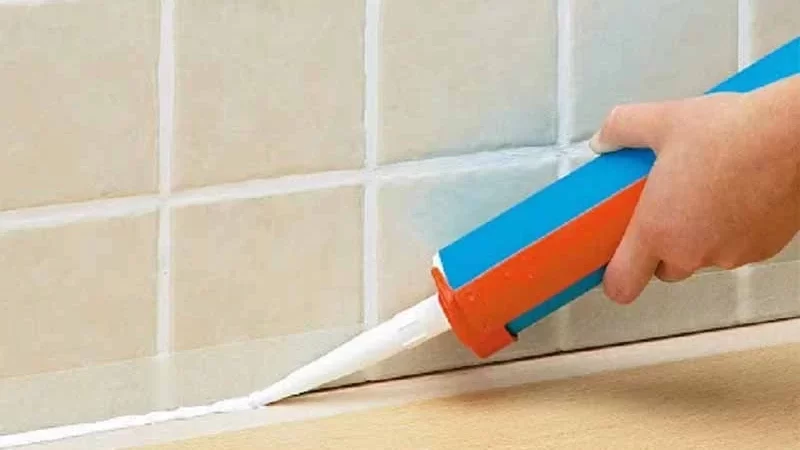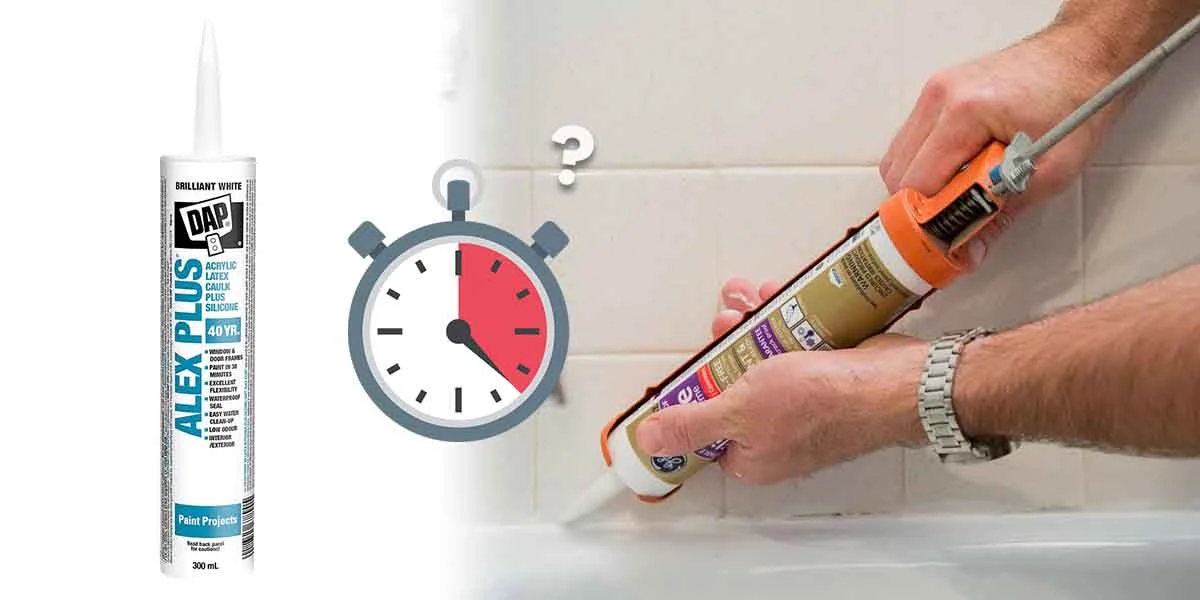Caulking is done around the house to seal the gaps between different surfaces. For instance, you might have seen a white layer on the edges filling gaps between your bathtub and wall. It is done to prevent water and moisture from entering the gaps, causing damage.
Once applying caulk, you must let it dry and cure completely. Otherwise, you may accidentally wash it away, letting your hard work get wasted.
Generally speaking, caulk which is advertised as “fast-drying,†takes an hour to dry completely. At this stage, the caulk is ready to be touched, but before exposing it to water you must let it cure. The curing process usually takes longer than drying, mostly 24 hours.
Take a note,
The term “dry” and “cure” are often used mutually. The biggest difference between dry and cure is they are two different phases. Drying is the phase when solvents such as water and moisture evaporate from the caulk, leaving the surface dry. Curing is much slower which occurs after installing the caulk and its exposure to oxygen.
FantasticHandyman
The problem occurs when your caulk is unable to dry completely after long hours or days. In such cases, we need to figure out the cause and fix it.
In this guide, I will give you a few tips on how to speed up the caulk drying process. But before that, let’s understand the types of caulks and their behavior.
Read Later
- 6 Alternatives to Caulking Around the Bathtub (Must-Try!)
- How to Caulk A Large Gap In Bathtubs? (Step By Step Guide)
How Long Does It Take For Caulk To Dry & Cure?

Silicone Caulk
- Drying Time: 30 minutes or an hour
- Curing Time: 24 hours
Speaking of Silicone caulks, they are best suited for sealing indoor plumbing fixtures such as sinks, bathtubs, toilets, and showers. It might sound illogical, but for silicone caulks, a humid climate works best for speeding up the curing process.
How to Make Silicone Caulk Dry and Cure Faster? The warmer the temperature, the better your silicone caulk cures. You can place a humidifier to add moisture into the air, helping you dry and cure the silicone caulking much faster. Do not apply direct heat to speed up the process, it can have a negative result.
Acrylic Latex Caulk
- Drying Time: 30 minutes or an hour
- Curing Time: 24 hours
Acrylic latex caulks are best for painting applications like filling gaps between walls, woodwork trim, and ceilings. Most acrylic latex caulks behave the same as silicone caulks, taking about an hour to dry and 24 hours to cure completely.
How to Make Acrylic Latex Caulk Dry and Cure Faster? Acrylic latex needs something to evaporate the water solvent present on the caulk much quicker. The most affordable solution is to place a fan in front of the caulking area. Also, remember that Acrylic latex caulk cannot facilitate faster curing in humid climates. In this case, a dehumidifier can help eliminate moisture present in the air, fastening up dry and cure time.
Polyurethane Caulk
- Drying Time: 1-2 hour[s]
- Curing Time: 24 hours
Talking about Polyurethane caulks, they are one of the most flexible and versatile caulk available. Frequently used in the construction and automotive industry for purposes such as sealing wall/floor gaps or bonding fiberglass panels, etc.
Most polyurethane caulk takes 1-2 hours to dry and about 24 hours to cure completely. According to WaterproofCaulking, Polyurethane caulk also react with humid climate to facilitate faster curing. Sounds similar to Silicone caulk, Right?
How to Make Polyurethane Caulk Dry and Cure Faster? Place a humidifier and let it add moisture into the air. The higher moisture in the air, the faster it cures. As said earlier, do not apply direct heat to speed up the process, it can lead to a negative impact.
Recommended: I highly advise you to follow the curing instructions (if any) suggested by your caulk’s manufacturer.
5 Tips On How to Make Caulk Dry Faster (Must Try)
Choose the Right Caulk
One of the important factors to speed up the drying process is choosing the right caulk. Always go for caulk that is labeled as “fast-drying” because they have the potential to dry much faster than regular ones.
Generally, fast-drying caulks take 30 minutes or an hour to dry, depending on moisture levels in the air. Since drying and curing are two different stages, you will still have to wait for 24 hours to have it fully cured.
Sometimes you may wish to paint the caulk as soon as it is dry. In such cases, there are caulk formulas that are paintable after 30 minutes of application.
If you are looking for this purpose, Acrylic Latex Caulk is the one that is paintable just after drying with latex or oil-based paints. The good thing about such a caulk is it continues to cure even after getting it painted.
Clean the Surface Before Caulking
An uncleaned surface having old caulking, paint residue, mold, mildew, dirt, or debris is considered inappropriate for sealant adhesion. Before applying any caulk or sealant, it is always recommended to clean the surface thoroughly to get better bonding.
For cleaning the surface, take a wire brush and start peeling off the old caulking or rust present on the surface. Then, use rubbing alcohol or other disinfectants to clean the area.
Maintain Appropriate Temperature
Generally speaking, in winter, the curing time of Silicone caulk slows down because it needs a warmer climate to facilitate faster. Also, the cold temperature hurts polyurethane caulk’s curing time.
On the other hand, Acrylic Caulk is completely the opposite. It requires a moisture-free environment to fasten up its drying and curing time.
Every caulk manufacturer out there recommends a temperature at which caulking needs to be applied. Most of the time, a temperature around 40°F to 80°F is suitable to apply the caulk.
But I will recommend you to go through what your manufacturer prescribes. You can find these instructions on the product page, or if you have purchased the caulk, all instructions will be on the caulk tube.
Control the Moisture
Another factor that can affect drying/curing time is the amount of moisture present in the air.
As discussed earlier, caulks such as Silicone and Polyurethane require some humidity in the atmosphere to speed up the drying and curing time. That’s a reason why silicone and polyurethane take long hours to dry in seasons like winter.
Whereas, Acrylic Latex differs from both. The moisture particles on Acrylic caulking must evaporate to make it dry and cure faster. For that, you must maintain a humidity-free environment.
Here are a few solutions to Control the Moisture levels:
- Silicone & Polyurethane Caulks: Place a Humidifier and let it add moisture into the air. The higher moisture in air, the faster will be the curing.
- Acrylic Latex Caulks: Place a Dehumidifier and let it remove moisture from the air. The less moisture in air, the faster will be the curing.
Check Caulk’s Expiry Date
If you’ve kept the caulk in storage for longer, then probably it might have decayed over time. For a rough idea, unopened caulks are good for use within a year.
Silicone and Acrylic latex can deteriorate if it remains unopened for years. The same goes for Polyurethane caulks, as they are usable anywhere within a year.
According to HomeGuides, Once a tube of caulking has been opened, it’s impossible to store it for longer than a few months.
Here are a few things to make sure of:
- Always buy fresh caulk. Check the expiry date before purchasing one.
- If you are planning to use your old caulk, then also check the expiry date.
- Once the tube is opened, use the entire caulk. Do not store it for later use.
Related Post: How to Caulk A Large Gap In Bathtubs? (Step By Step Guide)



